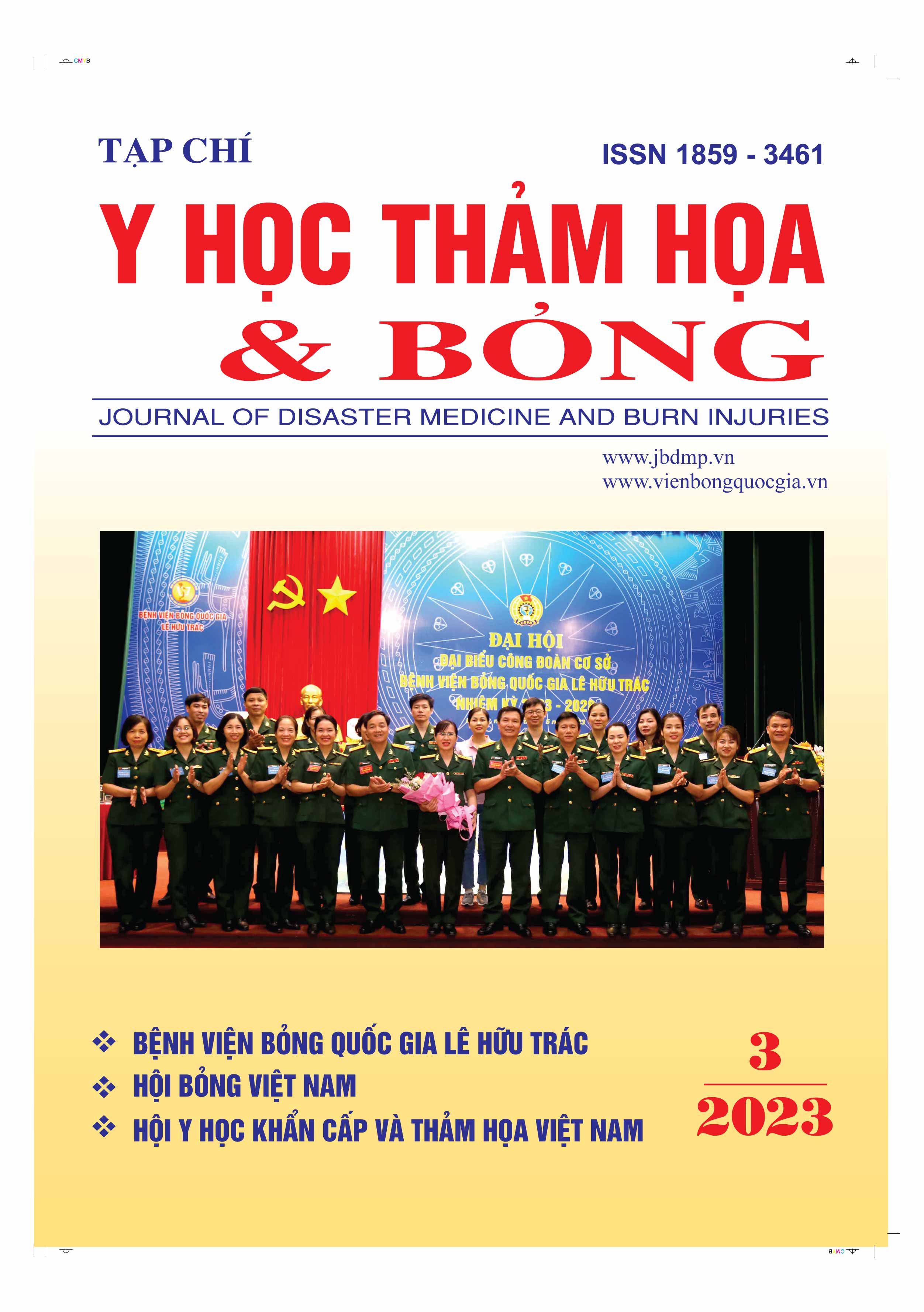Đánh giá tác dụng điều trị trên lâm sàng của gel HOCL tại chỗ vết thương mạn tính
Nội dung chính của bài viết
Tóm tắt
Nghiên cứu đánh giá tác dụng điều trị trên lâm sàng của Hemingel (gel chứa HOCl 0,02%) do Việt Nam sản xuất tại chỗ vết thương mạn tính; đối tượng nghiên cứu: 30 bệnh nhân bỏng có vết thương chậm liền, phương pháp: nghiên cứu tiến cứu, so sánh trước sau thử nghiệm; chỉ tiêu đánh giá lâm sàng toàn thân và tại chỗ. Kết quả: Viêm nề vết thương; dịch xuất tiết dịch mủ giảm rõ rệt, biểu mô hoá bờ mép tăng, mô hạt đẹp hơn, diện tích vết thương thu hẹp đáng kể, tạo thuận lợi cho ghép da. Không gặp các biểu hiện dị ứng, rối loạn toàn thân hoặc tại chỗ liên quan tới sử dụng thuốc.
Kết luận: Hemingel có tác dụng chống viêm và nhiễm khuẩn; tạo thuận lợi liền vết thương mạn tính; sử dụng trên bệnh nhân an toàn.
Chi tiết bài viết
Từ khóa
Vết thương mạn tính, gel HOCl, kháng khuẩn, kháng viêm, liền vết thương
Tài liệu tham khảo
2. Han G, Ceilley R (2017); Chronic wound healing: a review of current management and treatments. Adv Ther 34(3): 599-610
3. Boersema GC, Smart H, Giaquinto-Cilliers MG, et al. (2021). Management of unhealable and maintenance wounds: a systematic integrative review and referral pathway. Adv Skin Wound Care 34(1): 11-22
4. Fridman and Dino RechSibbald RG, Elliott JA, Ayello EA, Somayaji R (2015). Optimizing the moisture management tightrope with wound bed preparation. Adv Skin Wound Care; 28(10): 466-76.
5. Woo KY, Krasner DL, Kennedy B., et al (2015); Palliative wound care management strategies for palliative patients and their circles of care. Adv Skin Wound Care 28(3): 130-40, quiz 140-2
6. Woo K, de Gouveia Santos VLC, Alam T (2018); Optimising quality of life for people with non-healing wounds. Wounds International 9(3): 6-14
7. Krister Järbrink, Gao Ni, Henrik Sönnergren, Artur Schmidtchen, Caroline Pang, Ram Bajpai, and Josip Ca (2016). “Prevalence and incidence of chronic wounds and related complications: a protocol for a systematic review”. Syst Rev. 2016; 5(1): 152
8. Zhao R, Liang H, Clarke E, et al (2016). Inflammation in chronic wounds. Int J Mol Sci 17(12): 2085
9. Armstrong DG, Bohn G, Glat P, et al. Expert recommendations for the use of hypochlorous solution: science and clinical application. Ostomy Wound Manage. 2015; 61: S2-S19.
10. Block MS, Rowan BG. Hypochlorous acid: a review. J Oral Maxillofac Surg. 2020; 78: 1461-1466.
11. Day A, Alkhalil A, Carney BC, Hoffman HN, Moffatt LT, Shupp JW. Disruption of biofilms and neutralization of bacteria using hypochlorous acid solution: an in vivo and in vitro evaluation. Adv Skin Wound Care. 2017; 30: 543- 551.
12. Dissemond J. Wound cleansing: benefits of hypochlorous acid. J Wound Care. 2020; 29(10): S4- S8.
13. Medina-Tamayo J, Sanchez-Miranda E, Balleza-Tapia H et al. Superoxidized solution inhibits IgE-antigen-induced degranulation and cytokine release in mast cells. Int Immunopharmacol. 2007; 7: 1013-1024.
14. Draelos Z. Evaluation of a gel formulation of hypochlorous acid and sodium hypochlorite to reduce pruritus in mild to moderate atopic dermatitis. Winter Clin. 2012; 103: 624-628.
15. Rafael Herruzo Ph.D., MD, Erika Fondo Alvarez MSc, Irene Herruzo Ph.D., Emma Santiso Casanova MSc, Synergistic effect of two formulations of hypochlorous acid in the treatment of 346 chronic ulcers; wound repair and regeneration; Volume31, Issue3; May/June 2023; Pages 401-409
16. Del Rosso JQ, Bhatia N. Status report on topical hypochlorous acid: clinical relevance of specific formulations, potential modes of action, and study outcomes. J Clin Aesthet Dermatol. 2018; 11: 36-39.
17. Sakarya S, Gunay N, Karakulak M et al. Hypochlorous acid: an ideal wound care agent with powerful microbicidal, antibiofilm, and wound healing potency. Wounds. 2014; 26: 342-350.
18. Gold MH, Andriessen A, Bhatia AC, et al. Topical stabilized hypochlorous acid: the future gold standard for wound care and scar management in dermatologic and plastic surgery procedures. J Cosmetic Dermatol. 2020; 19: 270-277.
19. National Pressure Ulcer Advisory Panel (2016), NPUAP Pressure Injury Stages, http://www.npuap.org/
20. Menke N.B., Ward K.R., Witten T.M., Bonchev D.G., Diegelmann R.F (2007). “Impaired wound healing”. Clin Dermatol. 2007, 25:19-25


